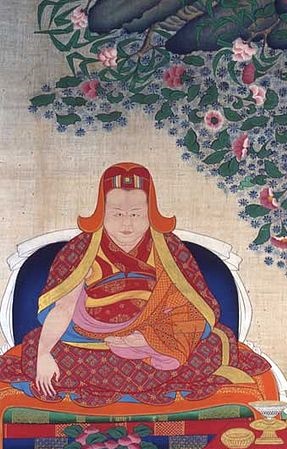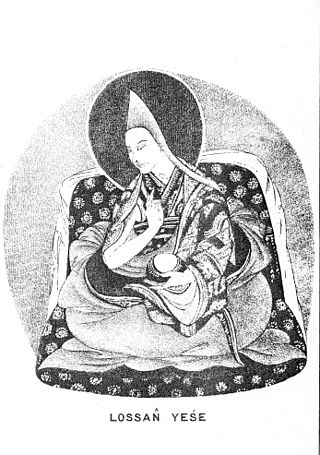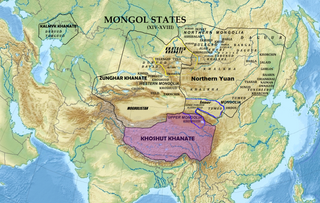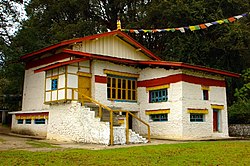
Dalai Lama is a title given by Altan Khan, the first Shunyi King of Ming China. He offered it in appreciation to the leader of the Gelug school of Tibetan Buddhism, Sonam Gyatso, who received it in 1578 at Yanghua Monastery. At that time, Sonam Gyatso had just given teachings to the Khan, and so the title of Dalai Lama was also given to the entire tulku lineage. Sonam Gyatso became the 3rd Dalai Lama, while the first two tulkus in the lineage, the 1st Dalai Lama and the 2nd Dalai Lama, were posthumously awarded the title.
The Monpa (Tibetan: མོན་པ་, Wylie: mon pa, THL: mön pa are a major people of Arunachal Pradesh in northeastern India and one of the 56 officially recognized ethnic groups in China. Most Monpas live in the Indian state of Arunachal Pradesh, with a population of 50,000, centered in the districts of Tawang and West Kameng. As of 2020 there were 11,143 Monpa people living in Le/ Lebo/ Lebugou/ Lebugou township of Cona/ Tsona Tsona City in the southern Tibet Autonomous Region, where they are known as Menba. Of the 45,000 Monpas who live in Arunachal Pradesh, about 20,000 of them live in Tawang district, where they constitute about 97% of the district's population, and almost all of the remainder can be found in the West Kameng district, where they form about 77% of the district's population. A small number of them may be found in bordering areas of East Kameng and Bhutan.
The 10th Dalai Lama, Tsultrim Gyatso (full given name Ngawang Lobzang Jampel Tsultrim Gyatso or Tsultrim Gyatso was the 10th Dalai Lama of Tibet, and born in Litang, Kham. He was fully ordained in the Gelug school of Tibetan Buddhism, studied the sutras and tantras, had several students, and rebuilt the Potala Palace.

Yonten Gyatso or Yon-tan-rgya-mtsho (1589–1617), was the 4th Dalai Lama, born in Tümed on the 30th day of the 12th month of the Earth-Ox year of the Tibetan calendar. Other sources, however, say he was born in the 1st month of the Earth Ox Year.

The 7th Dalai Lama, Kelzang Gyatso, was recognized as the authentic 7th Dalai Lama of Tibet. He was seen as the true incarnation of the 6th Dalai Lama, and was enthroned after a pretender supported by the Koshut Khan was deposed.

The 5th Dalai Lama, Ngawang Lobsang Gyatso was recognized as the 5th Dalai Lama, and he became the first Dalai Lama to hold both Tibet's political and spiritual leadership roles. He is often referred to simply as the Great Fifth, being the key religious and temporal leader of Tibetan Buddhism and Tibet. He is credited with unifying all of Tibet under the Ganden Phodrang, after Gushri Khan's successful military interventions. As an independent head of state, he established priest and patron relations with both Mongolia and the Qing dynasty simultaneously, and had positive relations with other neighboring countries. He began the custom of meeting early European explorers. The 5th Dalai Lama built the Potala Palace, and also wrote 24 volumes' worth of scholarly and religious works on a wide range of subjects.

Lobsang Yeshe (1663–1737) was the fifth Panchen Lama of Tibet.

Sera Monastery is one of the "great three" Gelug university monasteries of Tibet, located 1.25 miles (2.01 km) north of Lhasa and about 5 km (3.1 mi) north of the Jokhang.

Lha-bzang Khan was the ruler of the Khoshut tribe of the Oirats. He was the son of Tenzin Dalai Khan (1668–1701) and grandson of Güshi Khan, being the last khan of the Khoshut Khanate and Oirat King of Tibet. He acquired effective power as ruler of Tibet by eliminating the regent (desi) Sangye Gyatso and the Sixth Dalai Lama, Tsangyang Gyatso, but his rule was cut short by an invasion by another group of Oirats, the Dzungar people. At length, this led to the direct involvement of the Chinese Qing dynasty in the Tibetan politics.

Desi Sangye Gyatso (1653–1705) was the sixth regent (desi) of the 5th Dalai Lama (1617–1682) in the Ganden Phodrang government. He founded the School of Medicine and Astrology called Men-Tsee-Khang on Chagpori in 1694 and wrote the Blue Beryl treatise. His name is sometimes written as Sangye Gyamtso and Sans-rGyas rGya-mTsho

Trülku Drakpa Gyeltsen (1619–1656) was an important Gelugpa lama and a contemporary of the 5th Dalai Lama (1617–1682). His Seat was the upper residence of Drepung Monastery, a famous Gelug gompa located near Lhasa.
Yeshe Gyatso (1686–1725) was a pretender for the position of the 6th Dalai Lama of Tibet. Declared by Lha-bzang Khan of the Khoshut Khanate on June 28, 1707, he was the only unofficial Dalai Lama. While praised for his personal moral qualities, he was not recognized by the bulk of the Tibetans and Mongols and is not counted in the official list of the Dalai Lamas.

Chupzang Nunnery(Chu bzang dgon) is a historical nunnery, belonging to Sera Monastery. It is located north of Lhasa in Tibet, China. Though the site was established as a hermitage around 1665, it was converted into an exclusive nunnery in 1984 and has since grown into one of the largest nunneries in the Lhasa Valley.

The Khoshut Khanate was a Mongol Oirat khanate based in the Tibetan Plateau from 1642 to 1717. Based in modern Qinghai, it was founded by Güshi Khan in 1642 after defeating the opponents of the Gelug school of Tibetan Buddhism in Tibet. The 5th Dalai Lama established a civil administration known as Ganden Phodrang with the aid of Güshi Khan. The role of the khanate in the affairs of Tibet has been subject to various interpretations. Some sources claim that the Khoshut did not interfere in Tibetan affairs and had a priest and patron relationship between the khan and Dalai Lama while others claim that Güshi appointed a minister, Sonam Rapten, as de facto administrator of civil affairs while the Dalai Lama was only responsible for religious matters. Güshi Khan accepted the nominal suzerainty of the Qing dynasty in 1654, when seal of authority and golden sheets were granted by the Shunzhi Emperor. In the last years of the khanate, Lha-bzang Khan murdered the Tibetan regent and deposed the 6th Dalai Lama in favor of a pretender Dalai Lama.

The Ganden Phodrang or Ganden Podrang was the Tibetan system of government established by the 5th Dalai Lama in 1642, when the Oirat lord Güshi Khan who founded the Khoshut Khanate conferred all spiritual and political power in Tibet to him in a ceremony in Shigatse. During the ceremony, the Dalai Lama "made a proclamation declaring that Lhasa would be the capital of Tibet and the government of would be known as Gaden Phodrang" which eventually became the seat of the Gelug school's leadership authority. The Dalai Lama chose the name of his monastic residence at Drepung Monastery for the new Tibetan government's name: Ganden (དགའ་ལྡན), the Tibetan name for Tushita heaven, which, according to Buddhist cosmology, is where the future Buddha Maitreya resides; and Phodrang (ཕོ་བྲང), a palace, hall, or dwelling. Lhasa's Red Fort again became the capitol building of Tibet, and the Ganden Phodrang operated there and adjacent to the Potala Palace until 1959.
Tagtsepa Lhagyal Rabten was the regent of the Tibetan administration during the 3-year rule of the Dzungar Khanate in Tibet (1717–1720). He carried the Tibetan title sakyong. After the intervention by the troops of the Chinese Kangxi Emperor, he was executed by the Chinese on the charge of collaboration, thus began the period of Qing rule of Tibet.

Tibet under Qing rule refers to the Qing dynasty's rule over Tibet from 1720 to 1912. The Qing rulers incorporated Tibet into the empire along with other Inner Asia territories, although the actual extent of the Qing dynasty's control over Tibet during this period has been the subject of political debate. The Qing called Tibet a fanbu, fanbang or fanshu, which has usually been translated as "vassal", "vassal state", or "borderlands", along with areas like Xinjiang and Mongolia. Like the preceding Yuan dynasty, the Manchus of the Qing dynasty exerted military and administrative control over Tibet, while granting it a degree of political autonomy.

Jaisang Depa was born as Trinle Gyatso in the Ü province of Tibet around the beginning of the seventeenth century. He was also known as Drongmene meaning the person from Drongme village. A monk of the Geluk tradition, he served as Personal Assistant to Lobzang Gyatso, the Fifth Dalai Lama from 1632 to 1660. In 1660 he was appointed as Regent, de facto Ruler of Tibet, by Lobzang Gyatso, who renamed him at that point as Trinle Gyatso. In this post he succeeded Depa Norbu and retained it until his death in 1668. He was the Fifth Dalai Lama's third Regent out of a total of six and was succeeded by Lobzang Tutop.

















